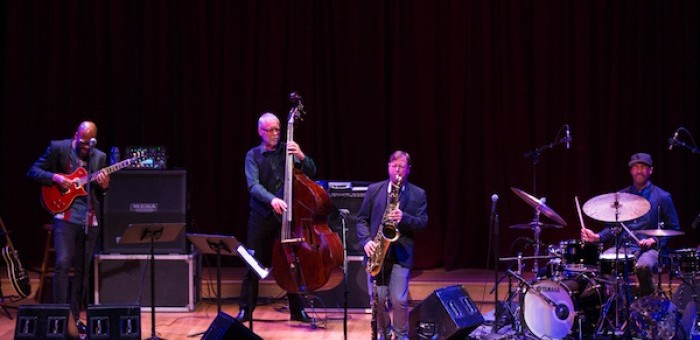Apr 2, 2024 12:59 PM
Saxophonist, Sonic Explorer Casey Benjamin Dies at 45
Casey Benjamin, the alto saxophonist, vocalist, keyboardist and producer who stamped his distinctive sounds on the…

Lionel Loueke (left), Dave Holland, Chris Potter and Eric Harland are Aziza. The supergroup performed in Cambridge, Massachusetts, on May 6.
(Photo: Robert Torres)During this baseball season, it’s a treat to sit in the crowded wooden bleacher seats of Fenway Park in Boston under a dome of big sky dreaming of catching a home run ball (or a bag of Fenway peanuts). Traveling a mile or so from Fenway, another buzzing capacity crowd gathered on May 6 in more elegant wooden pews and benches, under the beautiful domed ceiling of the historic Sanders Theatre at Harvard University in Cambridge, Massachusetts. The occasion: a soaring performance by Aziza, one of today’s most propulsive jazz partnerships.
Aziza is the creative synthesis of Dave Holland on bass, Chris Potter on saxophones, Lionel Loueke on guitars and Eric Harland on drums. The group last made their appearance in this region at the 2016 Newport Jazz Festival, where they performed an exuberant Sunday afternoon set.
Before commencing their concert (sponsored by the Celebrity Series of Boston), Holland announced that the foursome had not played together for some time, but that they were primed to “just jump in.” He said the group would play an uninterrupted set of member’s original compositions taken from their self-titled debut recording (released on Holland’s Dare2Records in 2016). He then coupled his bass with Loueke’s electric guitar to ignite the grooving “Aziza’s Dance.”
Taking the first solo, Loueke sounded more like a soulful blues organist than a guitarist. He spun out angular, electronic-shaded notes contrasted with rapid-fire strums (bending his knees in emphasis) as he drove home with intensity his funky, sharp-splintered attack.
Holland followed with a bass solo that rang with clarity, expressiveness and melodic invention. His bass resonated with funky bravado, combining slippery slides, bluesy holds and nimble caresses. Potter then took his turn in a brawny tenor solo in which he broke up the melodic line into shards of one-note punctuations. He started his funky journey down low and then meandered his way through his muscular register to a crescendo capped by high squeals.
This funk fest concluded with a solo from Harland, who displayed his resemblance to the great hitters of baseball lore: uncoiling in a slow-motion attack that effortlessly unleashed powerful cracks from his isolated snare and kick-drum. His churning solo moved with slowly evolving tension, all silvery lightness combined with elemental funk and rock beats.
The frisky creativity continued on Holland’s “Walkin’ The Walk,” highlighted by the bassist’s opening solo, in which he tossed perfunctory pauses, slurry slides and harmonic touches into the mix. With Loueke strolling on his wah-wah pedal for elastic undercurrent, Potter delivered a tenor solo marked by an ardent tone and meter shifts that slithered around Loueke and Holland’s web of bluesy, slow-brewing colors.
Potter’s dexterity in going from muscular glow to nimble dance on his horns was illustrated when he took up his soprano sax to take flight on another Holland original, “Finding The Light,” with his soprano scampering in incisively flexible and reedy tones. Midway through this piece, Potter switched again to his tenor to engage with Harland in a kinetic duet that combined Harland’s earthy ricochets with Potter’s jittery bursts of high notes and explosive honks.
Following this intense display, Loueke and Holland partnered in a lilting, peaceful moment, with Loueke singing in soft Yoruba-inspired phrases strums and Holland adding soft touches. This reflective calm evolved into Loueke’s buoyant “Sleepless Nights,” which crackled with the guitarist’s dynamic percussive effects, which effectively transformed his guitar into the sounds of an African talking drum. He then unleashed a flurry of Hendrix-inspired rifts in full rock glory that had everyone nodding in approval.
Harland followed Loueke’s volcanic concoction with a bone-rattling solo of his own, echoing his partner’s phrases with a slow-crawling snare pattern that erupted into a bolt of fluid fury.
After an ecstatic ovation, the band returned for an encore of Potter’s “Summer 15,” a buoyant piece that rode the slipstream of Holland’s Calypso riff and Harland’s wood rim snaps. Potter and Loueke joined the party, swinging with radiant twists of the melody in their spindly attacks and dashes of electronic color.
At the show’s conclusion, these consummate musicians gathered in a circle with smiles all around, clearly relishing the ebullient grooves that they had created in this, their most recent collective cavort. DB

Benjamin possessed a fluid, round sound on the alto saxophone, and he was often most recognizable by the layers of electronic effects that he put onto the instrument.
Apr 2, 2024 12:59 PM
Casey Benjamin, the alto saxophonist, vocalist, keyboardist and producer who stamped his distinctive sounds on the…

“He’s constructing intelligent musical sentences that connect seamlessly, which is the most important part of linear playing,” Charles McPherson said of alto saxophonist Sonny Red.
Feb 27, 2024 1:40 PM
“I might not have felt this way 30 to 40 years ago, but I’ve reached a point where I can hear value in what people…

Albert “Tootie” Heath (1935–2024) followed in the tradition of drummer Kenny Clarke, his idol.
Apr 5, 2024 10:28 AM
Albert “Tootie” Heath, a drummer of impeccable taste and time who was the youngest of three jazz-legend brothers…

“Both of us are quite grounded in the craft, the tradition and the harmonic sense,” Rosenwinkel said of his experience playing with Allen. “Yet I felt we shared something mystical as well.”
Mar 12, 2024 11:42 AM
“There are a few musicians you hear where, as somebody once said, the molecules in the room change. Geri was one of…

Larry Goldings’ versatility keeps him in high demand as a leader, collaborator and sideman.
Feb 21, 2024 10:45 AM
Are you having any fun? Larry Goldings certainly is. Consider just two recent examples:
Scene 1: “If anyone had…